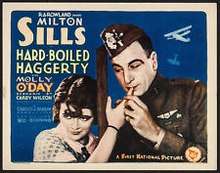Hard-Boiled Haggerty (film)
Hard-Boiled Haggerty (aka Hard Boiled Haggerty) is a 1927 American silent war film directed by Charles Brabin. The film stars Milton Sills and Molly O'Day, taking on two roles as both the character Germaine and her look-alike sister. Hard-Boiled Haggerty was one of the first American films to portray aerial combat in World War I.[1]
| Hard-Boiled Haggerty | |
|---|---|
 | |
| Directed by | Charles Brabin |
| Produced by | Wid Gunning |
| Written by | Carey Wilson |
| Based on | "Belated Evidence"(story) by Elliot White Springs |
| Starring | |
| Cinematography | Sol Polito |
Production company | |
| Distributed by | First National Pictures |
Release date |
|
| Country | United States |
| Language | Silent (English intertitles) |
Plot
After bringing down yet another German pilot and escaping uninjured from his burning aircraft, Haggerty (Milton Sills) and his buddy, aircraft machinist Klaxon (Arthur Stone), head for Paris, albeit without an official leave of absence. In escaping from M.P.'s, Haggerty takes refuge in a room occupied by Germaine Benoit (Molly O'Day). Love soon springs up, and Haggerty decides to reform, returning to Major Cotton (Mitchell Lewis) with this resolution. He is unprepared, however, to be awarded a medal for his actions as a fighter pilot.
Major Cotton, when introduced to Germaine at the officers' ball, recognizes her as "Go-Go" (Molly O'Day), a notorious cabaret dancer, and tries to tell Haggerty who she really is. Haggerty angrily knocks him down, and they are both arrested. At the trial, the major tells his story and Germaine confesses. After the Armistice, it develops that Go-Go is actually Germaine's sister, and that Germaine was trying to protect her. The two lovers Germaine and Haggerty are finally reunited.
Cast
- Milton Sills as Hard-Boiled Haggerty
- Molly O'Day as Germaine Benoit / "Go-Go" Benoit
- Mitchell Lewis as Major Cotton
- Arthur Stone as Klaxon, the mechanic
- George Fawcett as Brigadier-General
- Yola d'Avril as Cafe dancer
Production
Hard-Boiled Haggerty was based on a story by former World War I pilot Elliot White Springs, but was more of a romantic comedy than an aviation film.[2] Nevertheless, a number of aircraft were used in the production: Travel Air 4000, Travel Air 4000, Fokker D.VII and Thomas Morse S-4C.[3][4]
Reception
Aviation film historian James Farmer considered Hard-Boiled Haggerty, although one of the first films to depict the aerial conflicts of World War I, as light weight fare.[1] Aviation film historian Stephen Pendo noted that more action took place on the ground than in the air.[4]
References
Notes
- Farmer 1984, p. 41.
- Paris 1995, p. 40.
- Orriss 2013, p. 17.
- Pendo 1985, p. 79.
Bibliography
- Farmer, James H. Celluloid Wings: The Impact of Movies on Aviation. Blue Ridge Summit, Pennsylvania: Tab Books Inc., 1984. ISBN 978-0-83062-374-7.
- Orriss, Bruce W. When Hollywood Ruled the Skies: The Aviation Film Classics of World War I. Los Angeles: Aero Associates, 2013. ISBN 978-0-692-02004-3.
- Paris, Michael. From the Wright Brothers to Top Gun: Aviation, Nationalism, and Popular Cinema. Manchester, UK: Manchester University Press, 1995. ISBN 978-0-7190-4073-3.
- Pendo, Stephen. Aviation in the Cinema. Lanham, Maryland: Scarecrow Press, 1985. ISBN 978-0-8108-1746-3.